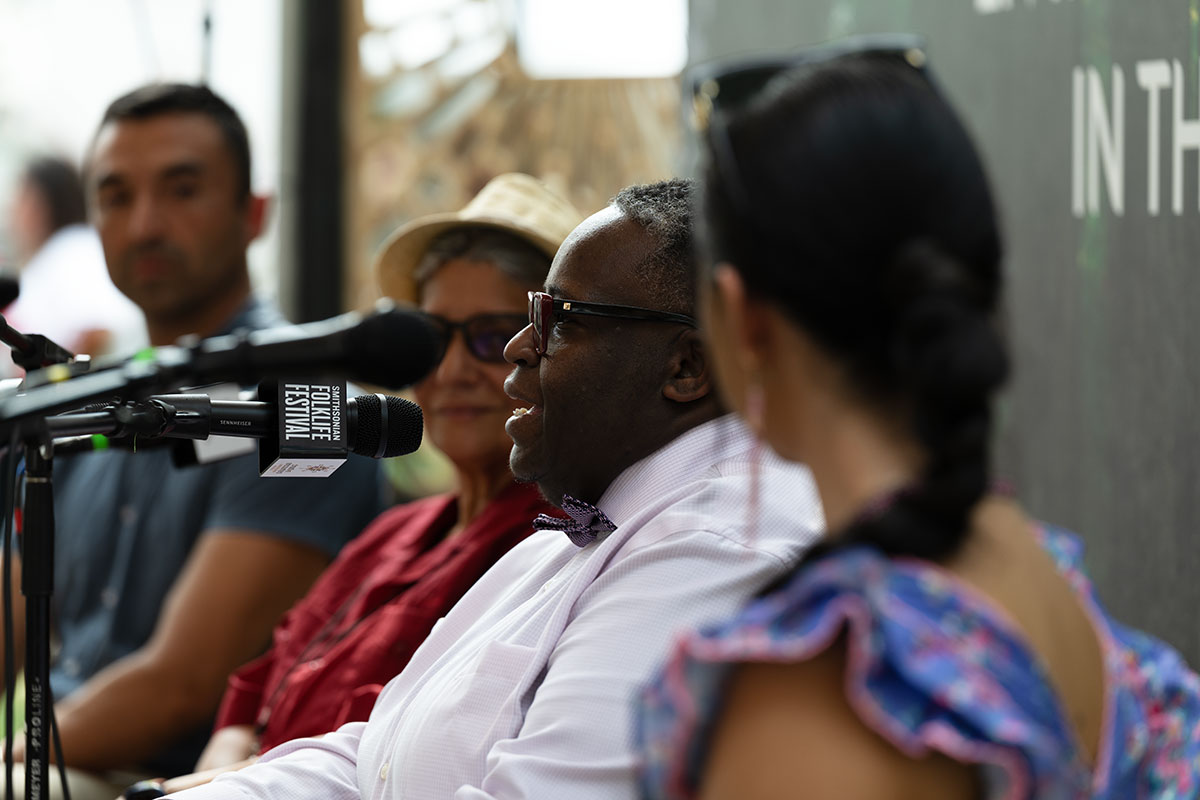How Three Queer Christians Reclaim Their Identity and Faith

The “LGBTQ+ Culture and Community-Building” panel at the 2023 Smithsonian Folklife Festival. Left to right: Danny Ballon-Garst, Lisbeth Meléndez Rivera, and Reverend Ali K.C. Bell.
Photo by Ronald Villasante, Ralph Rinzler Folklife Archives
As a theological studies master’s student at Harvard University, Danny Ballon-Garst remembers seeing posters reading “Queer and Religious?” promoting a discussion about whether it’s possible to be both. Since then, Ballon-Garst’s studies and career path have shown him that the answer is “yes.”
In fact, religious figures, including current or former clergy, have led much of the queer activism and community organizing around the question. But in a discussion with fellow faith leaders and activists at the Smithsonian Folklife Festival, that “yes” became more complicated.
Queer activism has historically focused on the struggles between queer people and religion. Ballon-Garst, Reverend Ali K.C. Bell, and community organizer Lisbeth Meléndez Rivera have faced discrimination from religious communities and acknowledged during the session how difficult it can be to reconcile homophobic people who use religious justification while practicing that religion themselves. But each detailed their own way of reclaiming their faith.
As a Black transmasculine Unitarian Universalist minister, Bell focuses on the difference between religion and spirituality. In his view, religions are created by people; they are collections of doctrines, practices, and traditions that govern how people interact with the divine. Spirituality is a person’s own connection to the divine that depends solely on their ability to connect to God. This distinction allows Bell to view the discrimination and hate that religion sometimes exhibits as an entirely human invention.
As he puts it, “God doesn’t fit into the box people have put God into, and I don’t have to fit into a box either.”
After Meléndez, a devout Catholic, encountered homophobia within her church, she explored other religious options. “I went to lots of other churches, Christian and otherwise, but every time I was upset, I’d go to a Catholic church, even if it was empty. The tranquility of a Catholic church allowed me, as a lesbian, to feel free to live my life.” She stuck with her faith throughout her involvement with queer activism during the late 1970s and early ’80s.
Eventually, a publisher asked her to edit a book, Our Witness: The Unheard Stories of LGBT+ Christians, that discussed how faith intersects with a variety of identities and social issues, including sexuality. In the process, she spoke with a wide range of people who shared their stories of living as both queer and religious, helping her form a new understanding about the Catholic hierarchy.
“The Catholic Church today exists at three levels,” she explained. “In corporate terms, you have the upper management: the Vatican. Then you have middle management: the bishops and priests. And then you have the pews, and in almost every church I’ve ever visited, people will love you at the pews.”

All three speakers use a strong theological foundation, plus degrees in theology, to critique those who use faith to spread hate. The main problem they see is apathy. Even though many religious people are loving and accepting of queer people, they must be more vocal and take action to show their support. Bell sees abandoning faith as giving up.
“I needed to turn around and do the work inside of the places that turned people like me away and say this is not what God is,” he said. He believes that this involves closely studying faith traditions to understand how their teachings can be twisted. Studying scripture can prepare queer people to push back against homophobic interpretations of faith because they will know what they are arguing against. To him, “oppression is something we manufacture every day, and we can’t make religion work by oppressing people.”
Meléndez calls the conservative religious homophobia “theology by scalpel,” particularly in relation to the Bible and the seven verses some claim to be anti-queer. She points out to conservatives that there are 35,000 other verses that tell queer people they are loved by virtue of being children of God. This goes back to the difference between religion and spirituality. These debates aren’t about how God feels—they’re about how people feel about differences. She wants to impress upon religious conservatives that “you have a right to exist without trampling on my right to exist.”
Ballon-Garst, who is now a doctoral candidate in American religious cultures at Emory University, worries that this religious approach is disappearing in the queer community. He cited a recent study that shows that fifty-six percent of LGBTQ+ Americans claim a religious affiliation, though that only applies to people ages fifty to sixty-four. “That statistic does not hold true for young people, who, at a much greater rate than the general population, are moving away from religion,” he claimed. Ballon-Garst sees this as a major concern. He points out that studies consistently show that people are more likely to be accepting of queer people when they have a personal connection to a member of the community, so the focus should be on building those relationships.
Bell and Meléndez agreed with Ballon-Garst, and Bell looks forward to a future where queer people are fully encompassed by religion and no one must choose. Ballon-Garst envisions “a future in which our queer religious institutions do whatever it takes to reach young people.”
Meléndez stated her opinion bluntly: “For as long as you believe religion is the enemy, you will lose.”
Eileen Jones is a writing intern at the Center for Folklife and Cultural Heritage. She is a junior at George Washington University where she studies creative writing and American studies.

